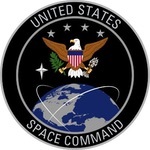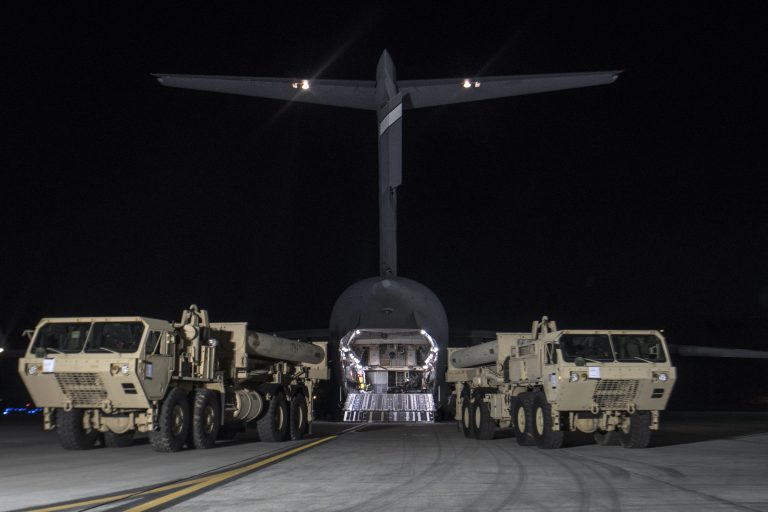31.08.2019

President Donald Trump launched a new Pentagon command dedicated to warfare in space Thursday, as American armed forces chiefs see China and Russia pressing hard to erode the US advantage in the newest military frontier.
"This is a landmark day, one that recognizes the centrality of space to America's security and defense," Trump said in a White House ceremony.
"SpaceCom will ensure that America's dominance in space is never threatened."
The new command will elevate space -- largely the satellites and high-altitude aircraft essential to modern-day warfare -- to a focused theater of combat, the equal of the US Central Command governing the Middle East and the Pacific Command, which manages defenses in the Western Pacific and Asia.
While the US Air Force already has a dedicated space warfare operation, SpaceCom will heighten its importance
and foster specialized systems and training for space showdowns.
"The dangers to our country constantly evolve and so must we," said Trump.
"Our adversaries are weaponizing earth's orbits with new technology targeting American satellites that are critical to both battlefield operations and our way of life at home."
"Our freedom to operate in space is also essential to detecting and destroying any missile launched against the United States," he added.
Air Force General John Raymond, who will lead the new command, said ahead of the White House ceremony that US rivals China and Russia are already pouring huge resources into space operations, where they believe they can, in a conflict, diminish US advantages.
The challenges range from adversaries jamming communications and GPS satellites to, as China demonstrated in 2007, ground-launched missiles used to physically destroy satellites.
- After SpaceCom, US Space Force -
"We are at a strategic inflection point where there is nothing that we do as a joint coalition force that isn't enabled by space," Raymond told reporters at the Pentagon.
"I'm convinced that space is a war-fighting domain. I'm convinced that our way of life and our way of war depend on space capabilities," he said.
The Space Command is the Pentagon's 11th full command and second launched in two years.
Last year the Pentagon elevated its cyber warfare operations to CyberCom, recognizing that online attacks and defense constituted a unique theater of combat.
Trump though has a much more ambitious vision for space warfare.
In June 2018 he ordered the Department of Defense to create a much larger Space Force, a dedicated branch of the military equal to the existing forces, the US Army, Air Force, Navy, Marines and Coast Guard.
That much more ambitious and expensive move would require Congress's approval. Some in the Pentagon, including the former defense secretary James Mattis, have opposed the idea as unnecessary and creating new bureaucracy.
"SpaceCom will be followed by the establishment of the United States Space Force as the sixth branch of the United States armed forces," Trump said Thursday.
"The Space Force will organize, train and equip warriors to support SpaceCom's mission."
Steve Kitay, Deputy Assistant Secretary of Defense for Space Policy, said a proposal could be added to the Defense Department's budget in the coming year, calling it a "strategic imperative."
In China and Russia, he said, "there is a perception that space represents an [American] Achilles heel and that this is an asymmetric advantage for them to then take on the United States' power."
"Space will not be an Achilles heel" for the US, he said.
Quelle: Franc24
----
Update: 1.09.2019
.
SPACECOM is a go: Newest combatant command signed into existence

WASHINGTON — The Pentagon has a new combatant command.
With a twirl of the pen, Secretary of Defense Mark Esper signed into creation U.S. Space Command, the 11th war-fighting command for the Defense Department.
“This is a landmark day, one that recognizes the centrality of space to America’s national security and defense," President Donald Trump said during the event, held in the Rose Garden of the White House.
“It’s all about space,” Trump said, adding that for anyone looking to challenge the U.S. in orbit, “it’s going to be a whole different ballgame.”
Air Force Gen. Jay Raymond is the new head of SPACECOM; Army Lt. Gen. James Dickinson has been nominated to become the deputy commander. Upon Trump’s signature, 287 individuals, pulled largely from U.S. Strategic Command, became the first members of the new command.
Earlier in the day, Raymond and Stephen Kitay, deputy assistant secretary of defense for space policy, told reporters the creation of SPACECOM marked a new era in how the Defense Department approaches space.
“We are at a strategic inflection point. There is nothing that we do [as a joint force] that isn’t enabled by space. Zero,” Raymond said. “Our goal is to actually deter a conflict from extending into space. The best way I know how to do that is to be prepared to fight and win” should deterrence fail.
SPACECOM’s mission falls into four broad categories:
- To deter potential adversaries in space.
- To defend American assets in orbit.
- To deliver war-fighting capabilities (such as GPS) to other combatant commands.
- To develop joint war fighters to be able to operate in the space domain.
The command will include a traditional headquarters staff, service components from all four armed services and two operational components: Combined Forces Space Component Command — focused on integrating space capabilities around the globe and throughout joint coalition partners — and Joint Task Force for Space Defense — focused on protecting and defending the war-fighting domain.
“Space will not be an Achilles’ heel. We will protect and defend and provide it for our way of life and our way of war,” Kitay added.
Technically, this is a relaunch of SPACECOM, which existed in another form from 1985 through 2002. However, Raymond said, the two organizations are very different, with a “sharper” focus on the dangers from other nations in space a key part of the new incarnation. Those threats include kinetic and non-kinetic activities from competitors such as China and Russia — and any future competitors who might gain space capabilities in the future.
As if to underscore the changing space environment, news broke Thursday that Iran’s most recent attempt at a space launch appears to have failed on the ground. The effort was the third failed launch attempt this year, but the effort shows Iran is willing to invest significant national capital into putting assets into orbit.
SPACECOM will continue to grow, including a final selection on the location of its headquarters. But questions remain about integration plans with an eventual Space Force, should Congress back its creation as a new military branch.
The budget for SPACECOM in fiscal 2020 was $83.8 million, of which $75.6 million was shifted from previous organizations.
Raymond warned that a continuing resolution this year would have a “significant impact” on the standing up of the new command. “We need to have stable budgets as we build this command. Continuing resolutions are never good, and it would be bad in this case as well,” he said.
Quelle: DefenseNews
+++
Space Command Launched At Rose Garden, Gen. Raymond Speaks On Anti-Satellite Weapons
President Donald Trump, at the White House Rose Garden, said: "Our adversaries are weaponizing Earth’s orbits with new technology targeting American satellites that are critical to both battlefield operations and our way of life at home. Our freedom to operate in space is also essential to detecting and destroying any missile launched against the United States."

WASHINGTON: On his first day as commander of the new Space Command, Gen. John Raymond outlined how the command will be made real — with a shift of almost 300 people from Strategic Command and a spare budget of $83.8 million.
President Donald Trump, who spoke at the White House Rose Garden flanked by Vice President Mike Pence, Defense Secretary Mark Esper and Raymond at a short ceremony to announce the 11th combatant command, called it a “landmark moment.” Why create a Space Command again?
Here’s the president’s answer: “Our adversaries are weaponizing Earth’s orbits with new technology targeting American satellites that are critical to both battlefield operations and our way of life at home. Our freedom to operate in space is also essential to detecting and destroying any missile launched against the United States.”
He added that, “SPACECOM will ensure that America’s dominance in space is never questioned and never threatened, because we know the best way to prevent conflict is to prepare for victory.”
Raymond, in a briefing to reporters this morning, explained that the US is still the “best in the world in space,” but, he added, “our level of superiority is diminishing. So, we view the stand up of US Space Command as critical … It is a critical opportunity to stay ahead of that growing threat.”
Perhaps the biggest shift we’re seeing with SPACECOM’s creation is one that has been building up for several years — a greater public willingness to talk about potentially waging kinetic warfare in space.
Until Raymond’s first briefing with reporters in the Pentagon as the new commander, senior military officers and policymakers, including Gen. John Hyten, head of Strategic Command and nominated for vice chief of the Joint Chiefs of Staff, have repeatedly insisted that the US has no desire to use ASAT weapons that create space debris, and called for international norms against doing so.
Raymond, however, when asked directly if he thought all militaries should rule out the use of kinetic ASATs, did not go so far as to reject their use — while noting that deterrence remains the key goal.
“I’m convinced that we need to keep the domain safe for all the users. I’m convinced that space is a warfighting domain. I’m convinced that our way of life and our way of war depend on space capabilities,” Raymond said. “And I’m convinced that our primary focus is to deter that activity from happening. But that if deterrence were to fail, I’m also convinced we need to operate from a position of strength. And that’s what we are going to do.”
While the United States for decades has refused to rule out the use of any sort of ASAT in formal presidential policies or in Pentagon strategies and doctrine, at the same time national security leaders for the most part have just as consistently carefully distanced themselves from publicly supporting destructive ASATs. Instead, the US has championed international debris guidelines, and the creation of new norms of behavior, designed to avoid creation of space debris — already a problem for all space operators. Further, the State Department continues at nearly every multilateral meeting on space issues to condemn China for its 2007 ASAT test that created thousands of pieces of space debris.
Up to now, what we know about the (largely classified) counterspace weapons development is that it has been focused on so-called temporary and reversible means; i.e. jamming radio frequencies or blinding optical sensors with lasers. The only publicly acknowledged operational counterspace weapon in the Air Force arsenal is the Counterspace Communications System, a mobile system that can be deployed globally to provide uplink jamming capability against communications satellites based in geostationary (GEO) orbit.
However, back in April, then-Air Force Secretary Heather Wilson said that the US may soon need to demonstrate new satellite attack capabilities — although she didn’t say what sort. Further, US spending ‘space control’ — the term of art for both defensive and offensive space capabilities — has been increasing over the past several years, although again much of it is classified.
The new Space Command website also seems to be suggesting a stronger emphasis in future for offensive operations. It states: “Our overriding objective is the establishment, defense, and preservation of U.S. and Allied space superiority through space combat operations (emphasis ours) for the sake of continued freedom of operations in space.”
UPDATE STARTS. “I think it is troubling that the first instinct of some when discussing space defense is that you must match offense with offense,” Doug Loverro, former deputy assistant secretary of defense for space policy, said. “There is no theory of space combat, nor will there ever be any theory of space combat, where your kinetic ASAT prevents the other guy’s kinetics ASAT. It’s a false equivalency notion rooted in a theory of mutually assured destruction which works for nuclear weapons, but not for ASATs.
“Meanwhile there are many ways to disable an adversary’s space craft without blowing it to bits. Yes they are more expensive and harder to do,” he added. “But just as in terrestrial warfare, we often select harder more expensive technologies over those that may be easier and cheaper, but create more collateral damage. Such is the case in chemical weapons. The same must be true for space.” UPDATE ENDS.
Brian Weeden, director of program planning for the Secure World Foundation, said that “the idea is that the US military may need ASAT weapons of its own to take out Russian or Chinese satellites in a future conflict, for example if they were being used to track and target U.S. ships. That’s not a new conclusion – the Ford and Carter Administrations came to the same conclusion more than 40 years ago.”
He added: “I can understand the military’s perspective that they want kinetic ASAT weapons as an option, but I think that’s a short-term tactical solution that creates more long-term strategic problems. For one, it further normalizes kinetic ASAT weapons as a responsible weapon of war, which encourages other countries to develop and possible use the same weapons. The US remains much more vulnerable to an adversary’s use of kinetic ASATs than they are to a US ASAT.”
In addition, he said, that position “also hands the Russians and Chinese a diplomatic bat they will continue to use to beat the United States over the head in diplomatic negotiations and mobilize other countries against US interests, while also making it harder for some of our allies to back us or cooperate.”
All that said, it is hard to parse whether we are seeing an active move to embrace destructive space warfare capabilities, or just more robust language designed to keep Russia and China guessing about US reaction to their possible use of killer space weapons.
For his part, Raymond’s top five priorities for SPACECOM did not include new weapon systems.
As the first priority, he said, “we’re going to seamlessly transition the responsibilities for space from US Strategic Command to US Space Command.”
Second, he said, is building toward “initial operating capability” for the new command. Raymond said that some 287 personnel initially will be shifted to staff SPACECOM headquarters from STRATCOM and the Joint Force Space Component Command. Further, STRATCOM’s five current operational centers will immediately be moved under SPACECOM, including the Combined Space Operations Center (CSpOC) at Vandenberg AFB and the National Space Defense Center at Schriever AFB.
Raymond stressed that the personnel involved are joint forces assigned to STRATCOM, not simply Air Force Space Command personnel. He noted, however, the exact end strength of the new command is still being worked out — as is where the HQ ultimately will be based. While Raymond said that six bases in the running, smart bets are on Peterson AFB or Schriever AFB in Colorado, with Vandenberg AFB in California a third possible choice.
Raymond said that the new command’s start-up budget is $83.8 million, with most of that — $75.6 million — representing transferred funds rather than new money.
The third priority is “to strengthen the relationships we have with the other combatant commands;” and as the fourth, “we want to continue to expand … allied cooperation, we view that as really critical.” Finally, he said, “we are going to continue to develop as joint warfighters.”
Quelle: Breaking Defense

